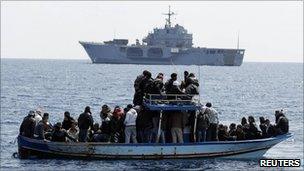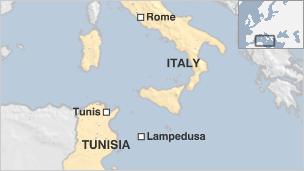Italian navy ship San Marco moves Lampedusa migrants
- Published

15,000 migrants have landed on Lampedusa since Tunisia's revolution in January
Hundreds of migrants who have arrived on the island of Lampedusa are being taken by Italian naval ship to Sicily.
Lampedusa has struggled to cope with the influx of 15,000 people from Tunisia since the January revolution.
The naval vessel San Marco is expected to take more than 600 people who will then be moved to holding centres.
Italian Interior Minister Roberto Maroni has warned of the possible flight of refugees from Libya as well and he has appealed for EU help.
Mr Maroni, who is due to travel to Tunisia later this week, is putting together proposals for Italian regions to take up to 50,000 migrants if there is a sudden influx from Libya.
"In dividing up immigrants between the regions we will bear in mind local population numbers," he said this week.
Immigrant tensions
Concerns about Lampedusa's ability to cope with the recent increase in migration have mounted across Italy.

More than 4,000 migrants are still on the tiny island and the Save the Children charity has complained that 230 unaccompanied children aged 12 to 17 are living in squalid conditions.
"The situation is bad as they don't have showers and only two toilets for 230 people," Save the Children child protection manager Carlotta Bellini told the BBC News website.
She said four of the children were being treated in hospital after cutting themselves with knives to draw attention to the situation.
The UN refugee agency says tensions are rising between migrants and the local population and there is "chaos and disorganisation".
Although many of the migrants have already been taken to Sicily or the mainland, new arrivals have continued to outnumber departures.
The normal winter population of Lampedusa, whose economy is based on tourism and fishing, is only 5,000. That has doubled with the influx of North Africans.
The mayor of Lampedusa is desperate for help to relieve pressure on the island's very limited resources.
- Published22 March 2011
- Published15 March 2011
- Published7 March 2011
- Published3 March 2011